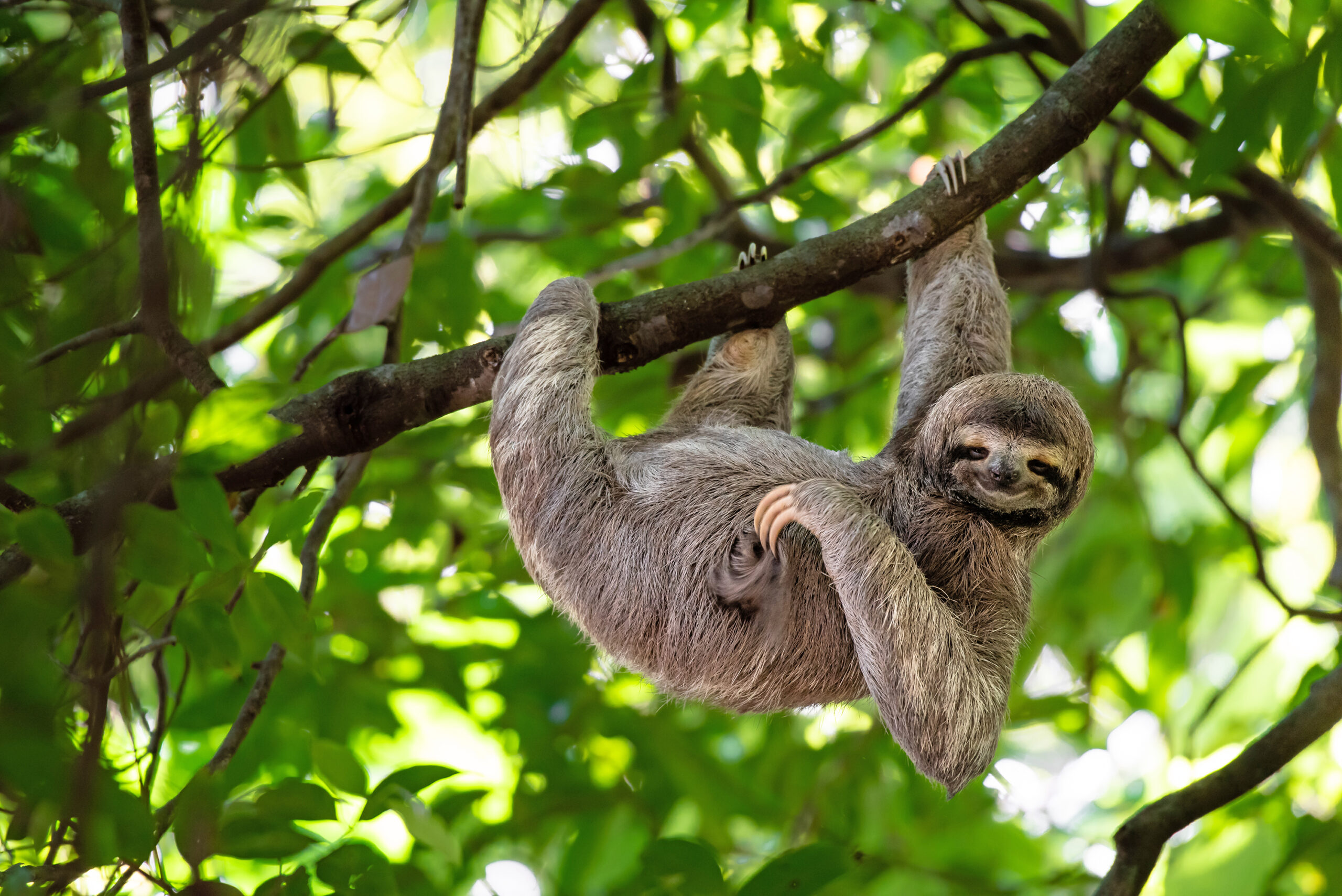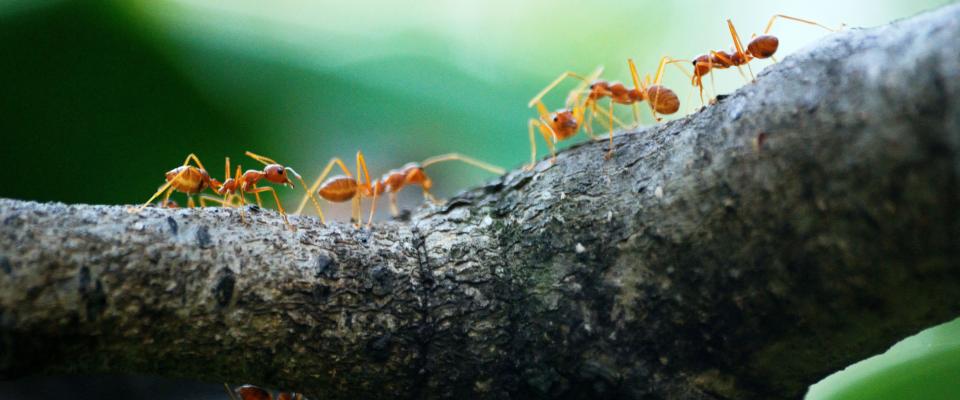Professor Neil Tsutsui talks hygiene, personal sacrifice, and other lessons humans can learn from eusocial insects.
It’s a warm, spring day. You’re sitting under a tree snacking on a bag of potato chips, when a breeze tickles your nose. You sneeze, sending a soggy crumb into the grass where it bonks an unsuspecting ant on the head. Unfazed, she nibbles the chip, then heaves it over her shoulder and carries it back to the colony. Little does she know that, during its brief flight from your mouth, this sticky glob picked up a fungal spore that is deadly to ants. Within a day she’ll be sick, within two she’ll be dead. And, so too, could her whole colony.

But, according to Neil Tsutsui, an expert in social insect biology and a professor of environmental science, policy, and management at UC Berkeley, that’s not likely to happen. “It’s probably not that common that a pathogen comes in and wipes out an entire colony. They have all of these things that seem to be pretty effective at preventing that from happening.”
According to Tsutsui, despite their “tiny little brains” and lack of individual intelligence, ants, bees, and other highly social insect species are uniquely adept at disease control. From preventative medicine to self-isolation, they’ve evolved many clever strategies to detect and prevent potentially devastating pandemics.
So, more than a year since the COVID-19 pandemic first reached the United States, as death tolls climb and vaccinations drag, might we learn a thing or two from the social insects crawling and buzzing around us? Tsutsui offers a qualified yes.
This conversation has been edited for length and clarity.
Highly social animals, like ants and bees, are particularly prone to disease. How do they protect themselves?
The eusocial insects—the ants, bees, wasps, and termites—have societies that are similar in some ways to really urbanized metropolitan areas. Within their colonies, they’re packed close together in large numbers, which creates a dynamic where diseases and parasites can spread really easily.
But then they also have some other features of social organization that make them even more vulnerable than we are. In many cases, a colony is headed by a single queen, which means that everybody else in a colony is a close relative. So if a disease gets a foothold in the colony and infects one individual, that probably means that others are likely to be susceptible to the same thing. And that also means that genetic diversity is low within a lot of these colonies. So if a pathogen sweeps through and wipes out all the vulnerable individuals, that’s likely to not leave behind many that are genetically different, that have some sort of resistance. And then, of course, some of these social insects, especially ants and termites, nest in soil or in rotten logs. So they come into close contact with a substrate that is full of bacteria and fungi.
All of these things are features of their biology that you would expect to make them vulnerable. [But] you know, ants have been around for over 150 million years. For the past 60 million years or so, they’ve been pretty abundant terrestrial organisms. Part of that is because they’ve evolved mechanisms to compensate for these vulnerabilities. There are tons of things they do to control pathogens in their colonies. They’re fairly clean organisms. If you watch an ant, or even a cockroach or a fly, for any length of time, one of the first things you’ll see them do is clean themselves. They’re constantly rubbing their hands. When they do that they’re removing spores of fungi from their body, they’re spreading around this waxy substance that acts as sort of a second skin to prevent microbes from getting inside their body.
So ants produce this wax and then spread it over themselves, almost like hand sanitizer?
It’s a multifunctional thing. These hydrocarbons probably evolved in insects initially to prevent them from drying out. Small organisms are really vulnerable to desiccation, and so this helps prevent that.
But they do also produce chemicals that are like hand sanitizers. We have a project going on in the lab right now where we’re looking at chemicals that are produced by Argentine ants, which are the ants that we have around our houses here in California. They use them as their trail pheromone, so when you see the ants marching along in a line, they’re following this chemical trail. But it turns out they also have them on their body, they put them on surfaces within their colony. And we’ve cultured bacteria and fungi from the soil that they nest in and shown that this chemical also has antimicrobial properties.
Besides keeping themselves clean, how else do social insects protect their colonies from disease?
Well one of the hallmarks of eusocial insects, and one of the things that makes them so fun and interesting to study, is that they have complex behaviors. During the lifespan of an ant, or a honeybee, they do different jobs. The youngest ant or the youngest honeybee, they take care of the other babies, they clean out some of the cells around where the brood are growing. The very oldest foragers go out in the world—they’re encountering pathogens and potentially bringing them back to the colony—but once they arrive back, they hand off the pollen or the nectar to somebody else inside the hive, who then takes it farther in and packs it in the food storage area. And those individuals are not the ones that are around the queen or taking care of the babies. The same is true for ants. And because of this organization of tasks, both spatially and across ages, it creates a barrier to pathogens getting in the colony.
One of those jobs actually is taking care of dead individuals. So the middle-aged bees will often go through a task repertoire known as “undertaking.” If there are dead or very sick individuals in the colony, they’ll pick them up and fly them 50 meters or 100 meters away and drop them. They want to get all of the dead individuals out of the colony. And ants do this, too. Ants in our lab colonies will make a graveyard in a distant corner where they put all of their dead individuals. They want to keep those away from everybody else.
They’re assuming that there’s something that killed them that would spread to the rest of the colony?
It’s just a hygienic behavior that has evolved. Individuals that, millions and millions of years ago, were picky about having dead ants in their colony had a higher survival rate. And that trait spread. There have been experiments where ants have been killed or made very sick with carbon dioxide, and they’ll remove them. In other cases, they can clearly recognize when an individual has been infected with a pathogen, so they will remove that individual, and they’ll groom themselves like crazy to make sure they don’t bring it back.
Then, of course, there’s the behavior of the sick individuals themselves. There’s lots of evidence from a variety of different species of ants that, if they are infected, they will self-isolate. They’ll do a shelter in place, but away from the colony. Experiments have used fungal pathogens that are known to kill ants. You can take an ant, and you can put spores on it from this pathogen. And then you take control ants and you just put saline solution with no spores on them. Over the course of a fairly short amount of time, a day or two, before the ants die, the ones that have the spores recognize that they’re getting sick, and they will go and self-isolate away from the colony.
Will healthy ants and bees ever take away the sick ones and sacrifice them to protect the colony?
It’s possible. I can’t think of any examples, but it wouldn’t surprise me if that happened.
One of the tricky things for these insects is to be able to accurately distinguish who’s dead and who’s not. They have all kinds of chemical signals they’ve evolved to indicate death. E. O. Wilson, the famous myrmecologist [one who studies ants], did these well-known experiments back in the ’50s or ’60s, where he identified a pheromone that is produced by dead ants and put it on living ants. And their nest mates would carry them alive, kicking and screaming, over to the graveyard, until they had cleaned enough of it off of themselves to not seem like they were dead.






You study really complex and impressive coevolutionary strategies that ants use to protect themselves, and then you look around the world, and people won’t even put on a mask. Does it ever feel like humans are sort of inferior?
These social insects have this amazing sort of unitary purpose. They function as a really sophisticated, coordinated machine, where individuals display really extreme altruistic behaviors that we would find unimaginable in any human society. If you start feeling like you’re getting a cold, there’s no way you’re going to wander off and live in the forest until you die of starvation.
There are lots of things that these social insects do that are beyond the capacity, I think, of human society. And there are reasons for that—they’re structured very differently than we are. One thing that sort of counts against us is we have the ability to somewhat predict the future based on history and our current circumstances. Given that, you would think that humans would be much better about taking actions that would secure our future.
You see variation across human societies as well. There are some places in the world that have gotten the response to COVID-19 down really well. New Zealand seems to have done an excellent job. And there are other societies that are at the opposite end of the spectrum. The United States is not doing great.
Part of the problem seems to be that this pandemic is asking us to take a more communitarian, global mindset even though humans are fundamentally more individualistic.
There are lots of things that we are willing to do that are demonstrations of altruistic behavior. We’re excellent at coordinating our individual behaviors toward a common purpose. But we also have many aspects of our behavior that are like a solitary insect where we’re looking out for ourselves and our close kin and our own individual interests. And I think that sort of solitary, individualistic perspective is what we’re seeing causing so many problems in the U.S. right now.
And then, of course, humans and our societies are complex. There are all kinds of things that just can’t be compared to other organisms like insects. Wearing a mask has become a symbol of something beyond just this pandemic; it’s a political indicator, in some ways. There are messages and misinformation coming in for political reasons or for reasons of personal profit. Those are things that don’t necessarily have a parallel in other organisms.

So, do you think that there are lessons to be learned from the way ant colonies respond to disease?
The one thing, above all else, that social insects can teach us is the power of cooperation and the power of many hands making light work. As humans, we have choices in the behaviors we exhibit. Whereas these social insects, they often don’t have a choice, right? They’re piloted by their genes and their evolutionary history. The example from the success of these social insects is the fact that they’re able to accomplish disease control as a result of their widespread cooperation. [This] suggests that, if we could just cooperate a bit more, then we would see similar success.
How might humans go about trying to build a more cooperative society?
It’s easy to see these societies of insects as very altruistic—these cooperative societies that are all working together toward a common goal. But these behaviors have been shaped by the same sort of selfishness that shapes solitary organisms. It’s really, in an evolutionary sense, just as selfish as favoring your own kids over somebody else’s. They’re still interested in increasing their fitness and transmitting as many of their genes to the next generation as they can. It just so happens that the way they can do that most effectively is by helping other individuals reproduce. The social insects that we’ve been talking about, for the most part, are the workers in the colony. And the reason that they’re able to do all of these crazy things like self-sacrifice and going off and dying sick and alone, is because those are the behaviors that allow them to spread their genes to future generations. Since they’re not having offspring themselves, they’re helping their mother, the queen, produce new queens and males that then start new colonies that go on into the future.






There’s this analogy for the social insects: the superorganism. I think there are lots of features about that analogy that ring true. An insect colony basically has reproductive cells that are separate from the somatic cells and nonreproductive cells—the queen versus the worker. They regulate their environment. They regulate food flow. In that analogy, these behaviors that decrease the spread of pathogens, it’s a form of immune system. It’s like a social immune system. When you see an insect society from the perspective of a superorganism, then it makes sense that they’re so united in the things that they’re willing and able to do.
Human society does not work nearly the same way. At the same time [that we’re] a society, we’re also individuals that are being propelled by our own individual motivations and needs. And those often conflict with the greater societal need. Whereas in the social insect colonies, those things are aligned.
So, would it be better if we were more like ants?
There are good things and bad things, right? Being an ant is a tough life. It is harsh and unforgiving. Ants are pretty brutal. We think we fight bad wars between countries in human societies, but ants are relentless and merciless in the wars they fight. So there are some things they do very well that are probably worth trying to emulate. And there are some things that are just terrible.
From the Spring 2021 issue of California.





















